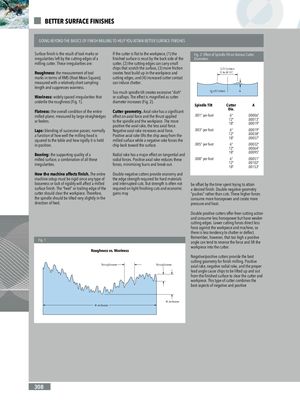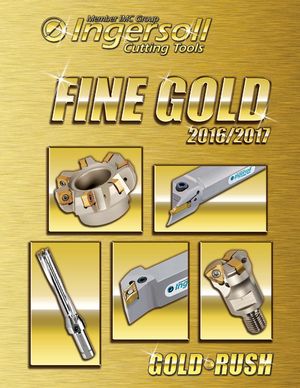Общий каталог Ingersoll 2011 - страница 306
Навигация
- 0003 Table of Contents
- 0006 End Mills
- 0064 Long Edge
- 0104 0Deg Face Mills
- 0160 Face Mills
- 0202 Slotters
- 0218 Form Mills
- 0236 Profile Mills
- 0302 Milling Tech
- 0384 Solid Carbide
- 0448 Solid Carbide Tech
- 0474 Holemaking & Thread Milling
- 0666 Holemaking & Thread Milling Tech
- 0720 Innofit Top On Toolholders
- 0738 HSK Toolholders
- 0774 CAT Toolholders
- 0796 BT Toolholders
- 0816 Adaptions Accessories
- 0872 Turning Inserts
- 1024 Turning Holders
- 1144 Turning Tech
- 1174 Threading Inserts
- 1242 Threading Holders
- 1256 Threading Tech
- 1268 T-Clamp
- 1344 T-Clamp Tech
- 1376 T-CAP
- 1388 T-CAP Tech
- 1394 Product_Index

BETTER SURFACE FINISHES GOING BEYOND THE BASICS OF FINISH MILLING TO HELP YOU ATTAIN BETTER SURFACE FINISHES Surface finish is the result of tool marks or If the cutter is flat to the workpiece, (1) the Fig. 2: Effect of Spindle Tilt on Various Cutter irregularities left by the cutting edges of a finished surface is recut by the back side of the Diameters milling cutter. These irregularities are: cutter, (2) the cutting edges can carry small chips that scratch the surface, (3) more friction 2/3 Cutter Roughness: the measurement of tool creates heat build-up in the workpiece and Dia. WOC marks in terms of RMS (Root Mean Square); cutting edges, and (4) increased cutter contact measured with a relatively short sampling can induce chatter. length and suppresses waviness. Too much spindle tilt creates excessive “dish” CLof Cutter A Waviness: widely spaced irregularities that or scallops. The effect is magnified as cutter underlie the roughness (Fig. 1). diameter increases (Fig. 2). Spindle Tilt Cutter A Flatness: the overall condition of the entire Cutter geometry. Axial rake has a significant Dia. milled plane; measured by large straightedges effect on axial force and the thrust applied .001” per foot 6” .00006” or feelers. to the spindle and the workpiece. The morepositive the axial rake, the less axial force.12” .00013”18”.00019” Laps: blending of successive passes; normally Negative axial rake increases axial force. .003” per foot 6” .00019” a function of how well the milling head is Positive axial rake lifts the chip away from thesquared to the table and how rigidly it is heldmilled surface while a negative rake forces the12”.00038”18”.00057” in position. chip back toward the surface. .005” per foot 6” .00032” 12” .00064” Bearing: the supporting quality of a Radial rake has a major effect on tangential and 18” .00095” milled surface; a combination of all these radial forces. Positive axial rake reduces these .008” per foot 6” .00051” irregularities. forces, minimizing burrs and break-out. 12” .00102”18”.00153” How the machine affects finish. The entire Double negative cutters provide economy and machine setup must be rigid since any type of the edge strength required for hard materials looseness or lack of rigidity will affect a milled and interrupted cuts. But strength is often not be offset by the time spent trying to attain surface finish. The “heel” or trailing edge of the required on light finishing cuts and economic a desired finish. Double negative geometry cutter should clear the workpiece. Therefore, gains may “pushes” rather than cuts. These higher forces the spindle should be tilted very slightly in the consume more horsepower and create more direction of feed. pressure and heat. Double positive cutters offer freer cutting action and consume less horsepower but have weaker cutting edges. Lower cutting forces direct less force against the workpiece and machine, so there is less tendency to chatter or deflect. Fig. 1 Remember, however, that too high a positiveangle can tend to reverse the force and lift the workpiece into the cutter. Roughness vs. Waviness Negative/positive cutters provide the best cutting geometry for finish milling. Positive Roughness Roughness axial rake, negative radial rake, and the proper lead angle cause chips to be lifted up and out from the finished surface to clear the cutter and workpiece. This type of cutter combines the best aspects of negative and positive Waviness Waviness 308
 Общий каталог Ingersoll 2016 - 2017
Общий каталог Ingersoll 2016 - 2017 Общий каталог Ingersoll 2014
Общий каталог Ingersoll 2014 Каталог Ingersoll инструмент для нарезания резьбы
Каталог Ingersoll инструмент для нарезания резьбы Общий каталог Ingersoll 2013 - 2014
Общий каталог Ingersoll 2013 - 2014 Каталог Ingersoll новинки 2021
Каталог Ingersoll новинки 2021